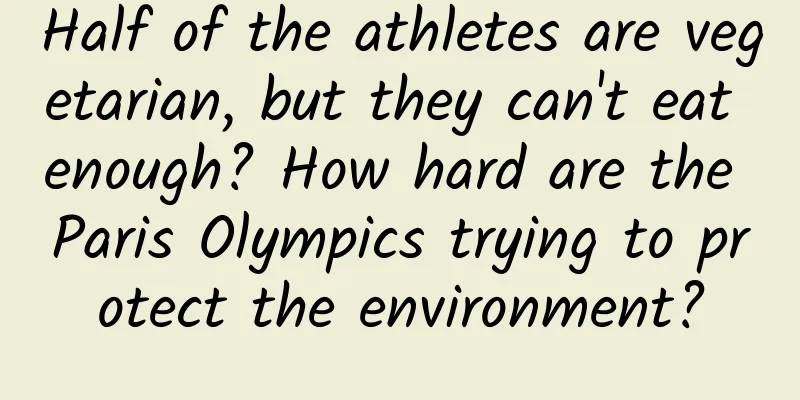Half of the athletes are vegetarian, but they can't eat enough? How hard are the Paris Olympics trying to protect the environment?

|
The motto of the Olympics is "Higher, Faster, Stronger", but for the Paris Olympic Organizing Committee, they may want to add one more - more environmentally friendly. As early as the bidding stage, Paris promised that they would host the most sustainable Olympic Games in history and the first Olympic Games that would meet the goals set out in the Paris Agreement on Climate Change. The Paris Agreement, adopted at the United Nations Climate Summit held in Paris in 2015, is the most important climate agreement to date. Its main content is to control the increase in global average temperature to below 2°C above pre-industrial levels, and strive to limit it to 1.5°C|Olympics.com The issue of sustainability in the Olympics has gradually gained attention. New stadiums may destroy natural habitats, and flying delegations and spectators from all over the world to the same city will generate a lot of carbon emissions. Disposable plastic products are often consumed during the event. The 2012 London Olympics and the 2016 Rio Olympics emitted an average of 3.5 million tons of carbon dioxide equivalents; due to the COVID-19 pandemic, there were only a small number of local spectators at the Tokyo Olympics, so carbon emissions were less than 2 million tons. Paris promised that they would reduce the carbon emissions of this Olympics to half of London and Rio , that is, 1.75 million tons. Paris is ambitious, but achieving this goal is not easy, and the reality is not as good as their plans. Food, clothing, housing and transportation can all be low-carbon In previous Olympic Games, carbon footprint was calculated only after the event ended; but this time, in order to achieve the goal, Paris conducted an assessment in the preparation stage . They divided the carbon budget into three parts: transportation (34%), construction (33%) and operation (including catering, accommodation, logistics, etc., 33%), and controlled carbon emissions through the "ARO principle". ARO refers to avoiding and reducing carbon emissions. For carbon emissions that cannot be avoided, they are offset by funding environmental protection projects. This principle has been implemented in all aspects of the Olympics. Venues: Reduce new construction Construction is currently the industry with the highest carbon emissions, accounting for about 37% of the world's total carbon emissions. This time, Paris will put 95% of the events in existing or temporary venues ; only a few venues such as the Olympic Village/Paralympic Village, the Aquatics Center, the Le Bourget Sports Climbing Hall, and the La Chapelle Porte Sports Hall were newly built for the Olympics. For existing venues, in addition to renovating stadiums, the French also turned some famous attractions into Olympic venues by building temporary facilities. For example, the Palace of Versailles built a temporary venue for equestrian events and modern pentathlon at the Paris Olympics; The Palace of Versailles is transformed into an equestrian competition venue|Château de Versailles / T. Garnier The Grand Palais in Paris, built in 1900 for the Paris World Expo, is used to host fencing and taekwondo competitions in the Olympic and Paralympic Games; Fencing competition held in the Grand Palais in Paris | Xie Zhiyang/ Lianhe Zaobao The beach volleyball competition will be held at the Eiffel Tower Stadium. The Eiffel Tower and beach volleyball game at sunset | Wei Xiaohao/China Daily When building new venues or temporary facilities, the Paris Olympic Committee also follows low-carbon principles, for example, using more recycled or reusable materials during construction, and increasing natural ventilation through design to reduce electricity demand. Aquatics Centre. According to officials, the 55-centimeter-thick wooden roof is a natural insulator; the depression in the middle reduces the interior volume of the venue, thereby reducing the energy required to heat and condition the air|Salem Mostefaoui / Olympics.com After the Olympics, several newly built venues will continue to be used. The Aquatics Center will become a comprehensive sports facility open to everyone, providing swimming, rock climbing and other sports venues; the Seine-Saint-Denis department where the rock climbing gym is located is extremely short of sports facilities, and the venue will be used by local associations and residents on a daily basis. 9,000 trees have been planted around the Athletes' Village, which is planned to be transformed into a community after the Olympics, including landscape parks, community stores, office buildings and 2,500 housing units, three-quarters of which will be provided as affordable housing to low-income groups and students. Equipment and Facilities: Rental and Used Materials By integrating the needs, the Paris Olympic Committee reduced all facilities and equipment from 800,000 to 600,000, and 75% of the sports equipment and electronic equipment are rented to reduce the waste caused by purchase. The Olympic Committee also promised that all equipment and 90% of the signs will be recycled and reused after the Olympics, and 100% of the materials used to build temporary facilities will have a second life. The purple running track that stands out from the circle. According to the manufacturer, the Paris Olympic running track uses 50% renewable and non-fossil materials, making it a more environmentally friendly running track than before|Paris 2024 For the newly built equipment, the Paris Olympic Committee used a lot of recyclable materials . For example, the podium this time was made entirely of recycled plastic and plastic foam food containers. It can be said that the athletes were standing on garbage to receive their awards! The podium at the Paris Olympics can be adjusted in length by adding or removing modules, from a minimum of 4 meters to a maximum of 33 meters, for football awards | Salem Mostefaoui / Olympics.com The podium was made by a French startup called Le Pavé, which also produced 11,000 spectator seats for the Olympics, made from 100 tons of recycled shampoo bottles and plastic bottle caps. Seats at the Aquatics Centre are made from plastic bottle caps | Salem Mostefaoui / Olympics.com In the athletes' village, beds and mattresses are made of reinforced cardboard and recycled fishing nets, and they will be recycled. In addition, there are coffee tables made of badminton and cushions made of parachute canvas at the Paris Olympics. The medals of this Olympics are, to some extent, the recycling of "waste materials": part of the Eiffel Tower was dismantled during its modernization last century; this time, the French took out these historical materials and re-forged them, adding the original iron of the Eiffel Tower to the center of each medal. The medal has a scrap piece of Eiffel Tower in the middle|Olympics.com Energy: 100% green energy In order to avoid the risk of power outages, major events in the past often relied heavily on large diesel generators. This time, the Paris Olympic Committee chose to use the public power grid to power the event. They calculated the amount of electricity that the venues would need to consume, and then purchased an equal amount of renewable energy ; the power company fed the electricity into the public grid to ensure the power supply of the event. According to the Paris Olympic Committee, these renewable energy sources come from 6 wind farms and 2 solar power plants; backup generators will also try to use hydrogen or biofuels. In addition to using renewable energy, the Paris Olympic Committee also reduced energy consumption by replacing high-efficiency equipment, such as LED lighting systems. The need for green energy was also taken into account when building new venues: the nearly 5,000 square meters of the roof of the Aquatics Center is paved with photovoltaics, which is one of the largest urban solar power plants in France and can meet about 20% of the venue's electricity needs; the heat recovered from the nearby data center is used to maintain the temperature of the swimming pool. The Aquatics Center hosts diving, water polo and synchronized swimming competitions, and the pool temperature is maintained using heat from a nearby data center | Olympics.com The Olympic Village does not have air conditioning installed , but uses high-performance insulation materials to reduce the amount of heat absorbed by the building. At the same time, underground pipelines are connected to the local geothermal power plant, and it is planned to use underground cold water for cooling in summer and hot water for heating in winter. However, in view of the record-breaking high temperatures in Paris in recent summers, the Olympic Village finally provided a mobile air conditioning rental service. A 1,000-square-meter photovoltaic carport was temporarily built in the Athletes' Village to provide self-generated electricity for the delegations of each country. A 400-square-meter mobile solar power plant was also built on the Seine River, which can provide electricity for about 30 two-bedroom apartments. These temporary facilities will be installed elsewhere for continued use after the Games. Photovoltaics are also installed on the roof of the Olympic Village to support the park's electricity needs|Sennse / Drone Press Catering: Local food, more vegetarian options 80% of the food provided to athletes at the Paris Olympics comes from local farms , thus reducing carbon emissions from food transportation. They offer global cuisine, but half of it is vegetarian , a higher proportion than in every previous Olympic Games. A plant-based meat company under Nestlé has also become a sponsor of the Olympics. However, the athletes were not full! Some athletes already had a high daily calorie intake, and the high-intensity training in preparation for the Olympics required more energy. Fortunately, Paris quickly adjusted the menu so that the athletes would not have to compete on an empty stomach. Paris prepared 50 dishes for the athletes, with 40 different dishes every day, with themes of French, Asian, African-Caribbean and world cuisine|Olympics.com The Olympic Village restaurant provides washable plates instead of disposable tableware. The mayor of Paris said last year that they decided to make the Paris Olympics the first major event without disposable plastics . The Paris Olympics allows spectators to bring their own water cups into the venue. They have cooperated with Coca-Cola to install 700 drinking points at the competition venues and provide reusable glass bottles; the marathon will also provide participants with reusable cups. However, Paris' determination to ban plastic may not be realized. Some people found that although the audience used reusable water bottles, the drinks they drank were Coca-Cola poured from disposable plastic bottles... Transportation: Shorten the distance between venues One-third of the Olympics' estimated carbon emissions are related to travel. Paris called on delegations and spectators to use low-carbon transportation to travel to France , which is difficult for distant countries, but it is feasible for nearby countries - athletes from Germany, Belgium, Britain, the Netherlands and Switzerland eventually took the train to Paris. Paris has also shortened the distance between venues as much as possible. 80% of the competition venues are within 10 kilometers of the Olympic Village , shortening the travel time of athletes. All venues can be reached by public transportation, and the total length of 60 kilometers of bicycle paths also provides more options for spectators to travel. In recent years, the number of bike lanes in Paris has doubled, and it is committed to becoming a 100% bikeable city | MDB Carbon offset: 1.47 million tons For the unavoidable Olympic-related carbon emissions, the Paris Olympic Organizing Committee purchases carbon credits equivalent to the emissions by funding environmental protection projects. Paris Olympic Committee has purchased 1,472,550 tons of carbon dioxide credits in 13 projects . Four of them are located in France, all of which are related to planting or restoring forests; the other nine are located abroad, including the installation of cooking systems and convenient water in Nigeria, Congo, Kenya and Rwanda, the opening of solar power plants in Senegal and Vietnam, and the protection of forests in Guatemala and Kenya and the restoration of mangroves in Senegal. Reality can’t keep up with plans? Paris does have an inherent advantage in hosting the lowest-carbon Olympics in history. This old international metropolis hosted two Olympic Games 100 years ago, and has also hosted major events such as the World Cup and the European Cup in the past 30 years. The venues and facilities built for these events can be used in this Olympics. In addition, Paris passed a climate action plan in 2007 to reduce urban carbon emissions and install solar panels, which also laid a solid foundation for Paris' low-carbon Olympics. The Bordeaux Stadium, where this football match was held, was built for the 2016 European Cup|Olympics.com However, the reality is not as good as the Paris plan . For example, the Olympic Village was not planned to be air-conditioned, but in the face of continuous high temperatures, the organizers had to provide portable air conditioners; the planned low-carbon catering was also adjusted because it could not meet the dietary needs of the athletes. All these will make the actual carbon emissions of the Paris Olympics exceed the budget. Some people also questioned whether Paris' marketing of the low-carbon Olympics was exaggerated . In addition to Coca-Cola, which used disposable plastics, another partner, Toyota, was also questioned. Toyota promised to provide 500 hydrogen-powered vehicles with zero tailpipe emissions for the Olympics, but some scholars pointed out to the International Olympic Committee that hydrogen-powered vehicles require three times more electricity than pure electric vehicles, and about 96% of hydrogen is still produced using fossil fuels, which is not a truly low-carbon approach. Moreover, under the current Olympic model, when spectators from all over the world fly to the same city to watch the event, the large amount of carbon emissions generated by long-distance travel will always be unavoidable in achieving the low-carbon goals of the Paris Olympics. Millions of spectators gathered in Paris to watch the games and have an unforgettable summer, but the amount of carbon emissions generated cannot be underestimated | Xavier Mari How much carbon emissions did the Paris Olympics actually produce and whether it really became the most environmentally friendly Olympics in history will have to wait until the end of the Olympics to know. However, when Paris promoted low carbon as a goal to the world, it was a good start - it showed how carbon reduction can be started from all aspects, reminding us how much carbon emissions are ignored in our daily lives; at the same time, this Olympics may also set a benchmark for future major events, making environmental protection a necessary option. The most watched global competition this summer is becoming a vivid footnote to environmental protection. Paris uses the Olympics to tell us that environmental protection is difficult, but we can take action. References [1] https://olympics.com [2] https://www.aljazeera.com/opinions/2024/7/26/what-to-watch-for-at-paris-2024-olympics-reusable-cups [3] https://www.spglobal.com/commodityinsights/en/market-insights/latest-news/energy-transition/072324-feature-paris-olympics-to-lean-heavily-on-offsets-clean-power-to-hit-carbon-targets [4] https://www.bbc.com/sport/articles/cm52drr0lp1o Author: Mai Mai Edited by: Yellowtail Pollock This article comes from GuokrNature (ID: GuokrNature) |
>>: Why did a nanomaterial researcher spark a passion for track cycling?
Recommend
These 3 key points can save you 50% of your promotion costs!
Whether for marketers or operators , advertising ...
User growth and basic process!
However, today's article wants to do one thin...
How can a product achieve explosive growth in users?
Competition among Internet products is essentiall...
Aurora Flash: Hello, the Sun Express has arrived!
On the evening of December 1, auroras appeared in...
Online earning project sharing: QQ group ranking + interception of the latest movie earning project
Working on a project is very interesting. Sometim...
Soul-searching question at the end of the year: Have you cured your procrastination?
The New Year is coming. To those of you who are d...
Live webcast: Is the regulatory storm coming to an end or just beginning?
Written in front: Are the good days of live strea...
Youqianhua application tips revealed! Teach you how to borrow money smoothly!
Since online lending platforms became popular, ma...
Popular Science | Little-known facts about Mandarin: How did the ancients speak “Mandarin”?
People who love costume dramas must have had a dr...
How did ancient ships find their way?
How to find ancient ships Direction of travel? Wi...
8 tips for advertising: Don’t wait until 50% of your advertising budget is wasted!
Whether for marketers or operators , how to adver...
What are the functions of energy drinks? You must know this!
Functional drinks are a must-drink for many peopl...
How to promote and operate App?
In recent years, mobile Internet has developed ra...
Don’t treat erythromycin ointment as a “national miracle drug”
Whether it is mosquito bites, acne, allergies, or...
APP Promotion Tips | Make good use of Weibo light application and you can use big tricks without spending any money!
Preface The concept of light applications was pro...









